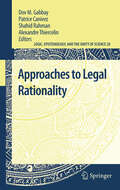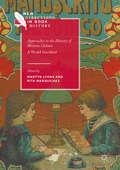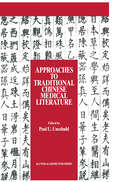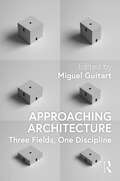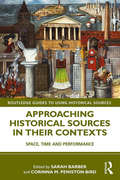- Table View
- List View
Approaches to History: A Symposium (Routledge Library Editions: Historiography)
by H. P. FinbergThe contributors to this volume, originally published in 1962, explain the raison d’être of their own specialism in history be it archaeology, political, local, economic or social history or historical geography.
Approaches to Legal Rationality (Logic, Epistemology, and the Unity of Science #20)
by Dov M. Gabbay, Patrice Canivez, Shahid Rahman and Alexandre ThiercelinLegal theory, political sciences, sociology, philosophy, logic, artificial intelligence: there are many approaches to legal argumentation. Each of them provides specific insights into highly complex phenomena. Different disciplines, but also different traditions in disciplines (e.g. analytical and continental traditions in philosophy) find here a rare occasion to meet. The present book contains contributions, both historical and thematic, from leading researchers in several of the most important approaches to legal rationality. One of the main issues is the relation between logic and law: the way logic is actually used in law, but also the way logic can make law explicit. An outstanding group of philosophers, logicians and jurists try to meet this issue. The book is more than a collection of papers. However different their respective conceptual tools may be, the authors share a common conception: legal argumentation is a specific argumentation context.
Approaches to Metaphysics (Studies in Philosophy and Religion #26)
by William SweetToday, when systematic philosophy - and reason itself - are challenged both outside of and within philosophy, is it still possible to do metaphysics? This volume provides a broad perspective on contemporary approaches to the nature and the fundamental questions of metaphysics. Drawing on scholars from continental Europe, Asia, Canada, the United States, and Great Britain, and representing a variety of philosophical cultures and traditions, this volume surveys and extends work in metaphysics and its implications for broader philosophical concerns (e.g., in ethics and social philosophy, in mathematics and logic, and in epistemology). It also addresses such questions as the role of history and historicity in undertaking metaphysics, the nature of metaphysics, the priority of metaphysics over epistemology, and the challenges of empiricism and postmodernism.
Approaches to Predicative Possession: The View from Slavic and Finno-Ugric (Bloomsbury Studies in Theoretical Linguistics)
by Gréte Dalmi Jacek Witkoś Piotr CegłowskiThis book discusses existential and possessive constructions in two important, yet under-studied, language families, Slavic and Finno-Ugric. Using data from the Slavic languages of Polish, Belarusian and Russian, and the Finno-Ugric languages of Finnish, Hungarian, Meadow Mari, Komi-Permiyak and Udmurt, as well as the closely related Selkup of the Samoyedic family, the chapters in this volume analyse predicative possession in current syntactic terms. Seeking an answer to the theoretical question of whether BE-possessives and HAVE-possessives are just accidental values of the 'Possessive Parameter' or are intrinsically related, this book takes a comparative approach to a whole range of syntactic and semantic phenomena that appear in these constructions, including the definiteness restriction, genitive of negation, person/number agreement, argument structure and extractability. The individual case studies can be easily integrated into the Principles & Parameters framework in terms of parametric variation. Approaches to Predicative Possession is an important contribution to our understanding of predicative possession across languages, with findings that can be fruitfully extended to other language families. It is an equally useful source of information for theoretical linguists, typologists, and graduate students of linguistics.
Approaches to Predicative Possession: The View from Slavic and Finno-Ugric (Bloomsbury Studies in Theoretical Linguistics)
This book discusses existential and possessive constructions in two important, yet under-studied, language families, Slavic and Finno-Ugric. Using data from the Slavic languages of Polish, Belarusian and Russian, and the Finno-Ugric languages of Finnish, Hungarian, Meadow Mari, Komi-Permiyak and Udmurt, as well as the closely related Selkup of the Samoyedic family, the chapters in this volume analyse predicative possession in current syntactic terms. Seeking an answer to the theoretical question of whether BE-possessives and HAVE-possessives are just accidental values of the 'Possessive Parameter' or are intrinsically related, this book takes a comparative approach to a whole range of syntactic and semantic phenomena that appear in these constructions, including the definiteness restriction, genitive of negation, person/number agreement, argument structure and extractability. The individual case studies can be easily integrated into the Principles & Parameters framework in terms of parametric variation. Approaches to Predicative Possession is an important contribution to our understanding of predicative possession across languages, with findings that can be fruitfully extended to other language families. It is an equally useful source of information for theoretical linguists, typologists, and graduate students of linguistics.
Approaches to Teaching the History of the English Language: Pedagogy in Practice
The History of the English Language has been a standard university course offering for over 150 years. Yet relatively little has been written about teaching a course whose very title suggests its prodigious chronological, geographic, and disciplinary scope. In the nineteenth century, History of the English Language courses focused on canonical British literary works. Since these early curricula were formed, the English language has changed, and so have the courses. In the twenty-first century, instructors account for the growing prominence of World Englishes as well as the English language's transformative relationship with the internet and social media. Approaches to Teaching the History of the English Language addresses the challenges and circumstances that the course's instructors and students commonly face. The volume reads as a series of "master classes" taught by experienced instructors who explain the pedagogical problems that inspired resourceful teaching practices. Although its chapters are authored by seasoned teachers, many of whom are preeminent scholars in their individual fields, the book is designed for instructors at any career stage-beginners and veterans alike. The topics addressed in Approaches to Teaching the History of the English Language include: the unique pedagogical dynamic that transpires in language study; the course's origins and relevance to current university curricula; scholarly approaches that can offer an abiding focus in a semester-long course; advice about navigating the course's formidable chronological ambit; ways to account for the language's many varieties; and the course's substantial and pedagogical relationship to contemporary multimedia platforms. Each chapter balances theory and practice, explaining in detail activities, assignments, or discussion questions ready for immediate use by instructors.
Approaches to the Byzantine Family (Birmingham Byzantine and Ottoman Studies #14)
by Leslie Brubaker Shaun TougherThe study of the family is one of the major lacunas in Byzantine Studies. Angeliki Laiou remarked in 1989 that ’the study of the Byzantine family is still in its infancy’, and this assertion remains true today. The present volume addresses this lacuna. It comprises 19 chapters written by international experts in the field which take a variety of approaches to the study of the Byzantine family, and embrace a chronological span from the later Roman to the late Byzantine empire. The context is established by chapters focusing on the Roman roots of the Byzantine family, the Christianisation of the family, and the nature of the family in contemporaneous cultures (the late antique west and the Islamic east). Key methodological approaches to the Byzantine family are highlighted and discussed, in particular prosopographical and life course approaches. The contribution of hagiography to the understanding of the Byzantine family is analysed by several authors; other chapters on the family and children in art and on the archaeology of the Middle Byzantine house explore the material evidence that can shed light on the Byzantine family. Overall, the diversity of families that existed in Byzantium (blood, fictive, metaphorical) is emphasised, and chapters consider the specific cases of ascetic, monastic, aristocratic and peasant families, as well as the imperial family, which is illuminated by the comparative case of a Caliphal family. The volume is topped and tailed by a Preface and an Afterword by the editors, which address the state of the field and consider the way ahead. Thus the volume is vital in putting the subject of the Byzantine Family in sharp focus and setting the research agenda for the future.
Approaches to the Byzantine Family (Birmingham Byzantine and Ottoman Studies #14)
by Leslie Brubaker Shaun TougherThe study of the family is one of the major lacunas in Byzantine Studies. Angeliki Laiou remarked in 1989 that ’the study of the Byzantine family is still in its infancy’, and this assertion remains true today. The present volume addresses this lacuna. It comprises 19 chapters written by international experts in the field which take a variety of approaches to the study of the Byzantine family, and embrace a chronological span from the later Roman to the late Byzantine empire. The context is established by chapters focusing on the Roman roots of the Byzantine family, the Christianisation of the family, and the nature of the family in contemporaneous cultures (the late antique west and the Islamic east). Key methodological approaches to the Byzantine family are highlighted and discussed, in particular prosopographical and life course approaches. The contribution of hagiography to the understanding of the Byzantine family is analysed by several authors; other chapters on the family and children in art and on the archaeology of the Middle Byzantine house explore the material evidence that can shed light on the Byzantine family. Overall, the diversity of families that existed in Byzantium (blood, fictive, metaphorical) is emphasised, and chapters consider the specific cases of ascetic, monastic, aristocratic and peasant families, as well as the imperial family, which is illuminated by the comparative case of a Caliphal family. The volume is topped and tailed by a Preface and an Afterword by the editors, which address the state of the field and consider the way ahead. Thus the volume is vital in putting the subject of the Byzantine Family in sharp focus and setting the research agenda for the future.
Approaches to the 'Chosen Place': Accessing a Biblical Concept (The Library of Hebrew Bible/Old Testament Studies)
by Rannfrid I. ThelleDeuteronomy's command to restrict cultic practice to one "chosen place" has occupied a central position in scholars' understandings of the book and their reconstruction of Israelite political and religious history. The debates about the date of Deuteronomy, its proposed connections to "Josiah's reform", and, most profoundly, the "Deuteronomistic History (DH) hypothesis" have dominated study of the idea of "chosen place". These debates have, to a large extent, determined how we read Deuteronomy and the Former Prophets in general. Through a reading of key texts from these corpora, this book provides a new, textually grounded, perspective of the "chosen place."
Approaches to the History of Written Culture: A World Inscribed
by Martyn Lyons Rita MarquilhasThis book investigates the history of writing as a cultural practice in a variety of contexts and periods. It analyses the rituals and practices determining intimate or ‘ordinary’ writing as well as bureaucratic and religious writing. From the inscribed images of ‘pre-literate’ societies, to the democratization of writing in the modern era, access to writing technology and its public and private uses are examined. In ten studies, presented by leading historians of scribal culture from seven countries, the book investigates the uses of writing in non-alphabetical as well as alphabetical script, in societies ranging from Native America and ancient Korea to modern Europe. The authors emphasise the material characteristics of writing, and in so doing they pose questions about the definition of writing itself. Drawing on expertise in various disciplines, they give an up-to-date account of the current state of knowledge in a field at the forefront of ‘Book History’.
Approaches to the History of Written Culture: A World Inscribed
by Martyn Lyons Rita MarquilhasThis book investigates the history of writing as a cultural practice in a variety of contexts and periods. It analyses the rituals and practices determining intimate or ‘ordinary’ writing as well as bureaucratic and religious writing. From the inscribed images of ‘pre-literate’ societies, to the democratization of writing in the modern era, access to writing technology and its public and private uses are examined. In ten studies, presented by leading historians of scribal culture from seven countries, the book investigates the uses of writing in non-alphabetical as well as alphabetical script, in societies ranging from Native America and ancient Korea to modern Europe. The authors emphasise the material characteristics of writing, and in so doing they pose questions about the definition of writing itself. Drawing on expertise in various disciplines, they give an up-to-date account of the current state of knowledge in a field at the forefront of ‘Book History’.
Approaches to Traditional Chinese Medical Literature: Proceedings of an International Symposium on Translation Methodologies and Terminologies
by Paul U. UnschuldProceedings of an International Symposium on Translation Methodologies and Terminologies
Approaching an Auschwitz Survivor: Holocaust Testimony and its Transformations (Oxford Oral History Series)
by Jürgen MatthäusAmong sources on the Holocaust, survivor testimonies are the least replaceable and most complex, reflecting both the personality of the narrator and the conditions and perceptions prevailing at the time of narration. Scholars, despite their aim to challenge memory and fill its gaps, often use testimonies uncritically or selectively-mining them to support generalizations. This book represents a departure, bringing Holocaust experts Atina Grossmann, Konrad Kwiet, Wendy Lower, Jürgen Matthäus, and Nechama Tec together to analyze the testimony of one Holocaust survivor. Born in Bratislava at the end of World War I, Helen "Zippi" Spitzer Tichauer was sent to Auschwitz in 1942. One of the few early arrivals to survive the camp and the death marches, she met her future husband in a DP camp, and they moved to New York in the 1960s. Beginning in 1946, Zippi devoted many hours to talking with a small group of scholars about her life. Her wide-ranging interviews are uniquely suited to raise questions on the meaning and use of survivor testimony. What do we know today about the workings of a death camp? How willing are we to learn from the experiences of a survivor, and how much is our perception preconditioned by standardized images? What are the mechanisms, aims, and pitfalls of storytelling? Can survivor testimonies be understood properly without guidance from those who experienced the events? This book's new, multifaceted approach toward Zippi's unique story combined with the authors' analysis of key aspects of Holocaust memory, its forms and its functions, makes it a rewarding and fascinating read.
Approaching an Auschwitz Survivor: Holocaust Testimony and its Transformations (Oxford Oral History Series)
by Mark Roseman Jürgen MatthäusAmong sources on the Holocaust, survivor testimonies are the least replaceable and most complex, reflecting both the personality of the narrator and the conditions and perceptions prevailing at the time of narration. Scholars, despite their aim to challenge memory and fill its gaps, often use testimonies uncritically or selectively-mining them to support generalizations. This book represents a departure, bringing Holocaust experts Atina Grossmann, Konrad Kwiet, Wendy Lower, Jürgen Matthäus, and Nechama Tec together to analyze the testimony of one Holocaust survivor. Born in Bratislava at the end of World War I, Helen "Zippi" Spitzer Tichauer was sent to Auschwitz in 1942. One of the few early arrivals to survive the camp and the death marches, she met her future husband in a DP camp, and they moved to New York in the 1960s. Beginning in 1946, Zippi devoted many hours to talking with a small group of scholars about her life. Her wide-ranging interviews are uniquely suited to raise questions on the meaning and use of survivor testimony. What do we know today about the workings of a death camp? How willing are we to learn from the experiences of a survivor, and how much is our perception preconditioned by standardized images? What are the mechanisms, aims, and pitfalls of storytelling? Can survivor testimonies be understood properly without guidance from those who experienced the events? This book's new, multifaceted approach toward Zippi's unique story combined with the authors' analysis of key aspects of Holocaust memory, its forms and its functions, makes it a rewarding and fascinating read.
Approaching Architecture: Three Fields, One Discipline
by Miguel GuitartThe study of the architectural discipline suffers from an increasing disconnect between its teaching and its professional practice. In this edited collection, 18 architectural voices address this disconnect by reflecting on the ways in which they exercise the architectural discipline in three ways: research, teaching, and practice. This book argues that the totality of activities encompassed by the architectural profession can be best fulfilled when reconsidering the critical interactions between these three fields in the everyday exercise of the profession. Split into three parts, "Architecture as Research," Architecture as Pedagogy," and "Architecture as Practice," each section focuses on one of these three dimensions while establishing continuity with the other two. In doing so, the book not only favors a more fulfilling interaction between academia and the profession but also reinforces the implementation of design theory and research in everyday teaching and practice. The contributions come from 18 teams of architects operating from geographically diverse locations, including Pezo von Ellrichshausen in Chile, Kengo Kuma & Associates in Japan, Barclay & Crousse in Peru, Shift in Iran, Heinrich Wolff in South Africa, and People’s Architecture Office in China, opening the design conversation to larger contexts and framing continuity and inclusion in time. Written for students, instructors, and practitioners alike, the inspiring reflections in this volume encourage readers to grow as architects and play an instrumental role in transforming the built environment.
Approaching Architecture: Three Fields, One Discipline
by Miguel GuitartThe study of the architectural discipline suffers from an increasing disconnect between its teaching and its professional practice. In this edited collection, 18 architectural voices address this disconnect by reflecting on the ways in which they exercise the architectural discipline in three ways: research, teaching, and practice. This book argues that the totality of activities encompassed by the architectural profession can be best fulfilled when reconsidering the critical interactions between these three fields in the everyday exercise of the profession. Split into three parts, "Architecture as Research," Architecture as Pedagogy," and "Architecture as Practice," each section focuses on one of these three dimensions while establishing continuity with the other two. In doing so, the book not only favors a more fulfilling interaction between academia and the profession but also reinforces the implementation of design theory and research in everyday teaching and practice. The contributions come from 18 teams of architects operating from geographically diverse locations, including Pezo von Ellrichshausen in Chile, Kengo Kuma & Associates in Japan, Barclay & Crousse in Peru, Shift in Iran, Heinrich Wolff in South Africa, and People’s Architecture Office in China, opening the design conversation to larger contexts and framing continuity and inclusion in time. Written for students, instructors, and practitioners alike, the inspiring reflections in this volume encourage readers to grow as architects and play an instrumental role in transforming the built environment.
Approaching Facial Difference: Past and Present (Facialities: Interdisciplinary Approaches to the Human Face)
by Patricia Skinner Emily CockWhat is a face and how does it relate to personhood? Approaching Facial Difference: Past and Present offers an interdisciplinary exploration of the many ways in which faces have been represented in the past and present, focusing on the issue of facial difference and disfigurement read in the light of shifting ideas of beauty and ugliness. Faces are central to all human social interactions, yet their study has been much overlooked by disability scholars and historians of medicine alike. By examining the main linguistic, visual and material approaches to the face from antiquity to contemporary times, contributors place facial diversity at the heart of our historical and cultural narratives. This cutting-edge collection of essays will be an invaluable resource for humanities scholars working across history, literature and visual culture, as well as modern practitioners in education and psychology.
Approaching Facial Difference: Past and Present (Facialities: Interdisciplinary Approaches to the Human Face)
by Patricia Skinner Emily CockWhat is a face and how does it relate to personhood? Approaching Facial Difference: Past and Present offers an interdisciplinary exploration of the many ways in which faces have been represented in the past and present, focusing on the issue of facial difference and disfigurement read in the light of shifting ideas of beauty and ugliness. Faces are central to all human social interactions, yet their study has been much overlooked by disability scholars and historians of medicine alike. By examining the main linguistic, visual and material approaches to the face from antiquity to contemporary times, contributors place facial diversity at the heart of our historical and cultural narratives. This cutting-edge collection of essays will be an invaluable resource for humanities scholars working across history, literature and visual culture, as well as modern practitioners in education and psychology.
Approaching Historical Sources in their Contexts: Space, Time and Performance (Routledge Guides to Using Historical Sources)
by Sarah Barber Corinna M. Peniston-BirdIn Approaching Historical Sources in Their Contexts, 12 academics examine how space, time and performance interact to co-create context for source analysis. The chapters cover 2000 years and stretch across the Americas and Europe. They are grouped into three themes, with the first four exploring aspects of movement within and around an environment: buildings, the tension between habitat and tourist landscape, cemeteries and war memorials. Three chapters look at different aspects of performance: masque and opera in which performance is (re)constructed from several media, radio and television. The final group of chapters consider objects and material culture in which both spatial placement and performance influence how they might be read as historical sources: archaeological finds and their digital management, the display of objects in heritage locations, clothing, photograph albums and scrapbooks. Supported by a range of case studies, the contributors embed lessons and methodological approaches within their chapters that can be adapted and adopted by those working with similar sources, offering students both a theoretical and practical demonstration of how to analyse sources within their contexts. Drawing out common threads to help those wishing to illuminate their own historical investigation, this book encourages a broad and inclusive approach to the physical and social contexts of historical evidence for those undertaking source analysis.
Approaching Historical Sources in their Contexts: Space, Time and Performance (Routledge Guides to Using Historical Sources)
by Sarah Barber Corinna M. Peniston-BirdIn Approaching Historical Sources in Their Contexts, 12 academics examine how space, time and performance interact to co-create context for source analysis. The chapters cover 2000 years and stretch across the Americas and Europe. They are grouped into three themes, with the first four exploring aspects of movement within and around an environment: buildings, the tension between habitat and tourist landscape, cemeteries and war memorials. Three chapters look at different aspects of performance: masque and opera in which performance is (re)constructed from several media, radio and television. The final group of chapters consider objects and material culture in which both spatial placement and performance influence how they might be read as historical sources: archaeological finds and their digital management, the display of objects in heritage locations, clothing, photograph albums and scrapbooks. Supported by a range of case studies, the contributors embed lessons and methodological approaches within their chapters that can be adapted and adopted by those working with similar sources, offering students both a theoretical and practical demonstration of how to analyse sources within their contexts. Drawing out common threads to help those wishing to illuminate their own historical investigation, this book encourages a broad and inclusive approach to the physical and social contexts of historical evidence for those undertaking source analysis.
Approaching Infinity
by M. HuemerApproaching Infinity addresses seventeen paradoxes of the infinite, most of which have no generally accepted solutions. The book addresses these paradoxes using a new theory of infinity, which entails that an infinite series is uncompletable when it requires something to possess an infinite intensive magnitude. Along the way, the author addresses the nature of numbers, sets, geometric points, and related matters.The book addresses the need for a theory of infinity, and reviews both old and new theories of infinity. It discussing the purposes of studying infinity and the troubles with traditional approaches to the problem, and concludes by offering a solution to some existing paradoxes.
Approaching Pipe Rolls: The Thirteenth Century (Approaching Medieval Sources)
by Richard CassidyThis is the first study specifically concerned with thirteenth-century pipe rolls and shows how pipe rolls were compiled, what they contain, and how to read them. These records of English government finance were produced annually. They list debts owed to the government, by the sheriffs of each county, by manors and boroughs, and by individuals for taxes, fines and judicial penalties. They also list the payments made, sometimes in cash to the treasury, sometimes for building works, fees for royal employees and relatives, the provision of castles, and much more. The rolls are an essential source for administrative history, and provide detailed information for family and local historians. All the rolls are now readily available, either in print or online, but they are at first sight difficult to understand. This book shows how the rolls evolved in the course of the century and serves as a guide for beginners, armed with some basic Latin, who want to explore these records. As well as explaining the conventions of dates, numbers, abbreviations, monetary units and so on, it illustrates the material to be found in pipe rolls by a detailed examination of a single roll.
Approaching Pipe Rolls: The Thirteenth Century (Approaching Medieval Sources)
by Richard CassidyThis is the first study specifically concerned with thirteenth-century pipe rolls and shows how pipe rolls were compiled, what they contain, and how to read them. These records of English government finance were produced annually. They list debts owed to the government, by the sheriffs of each county, by manors and boroughs, and by individuals for taxes, fines and judicial penalties. They also list the payments made, sometimes in cash to the treasury, sometimes for building works, fees for royal employees and relatives, the provision of castles, and much more. The rolls are an essential source for administrative history, and provide detailed information for family and local historians. All the rolls are now readily available, either in print or online, but they are at first sight difficult to understand. This book shows how the rolls evolved in the course of the century and serves as a guide for beginners, armed with some basic Latin, who want to explore these records. As well as explaining the conventions of dates, numbers, abbreviations, monetary units and so on, it illustrates the material to be found in pipe rolls by a detailed examination of a single roll.
Approaching Recent World History Through Film: Context, Analysis, and Research
by Scott C.M. BaileyApproaching Recent World History Through Film: Context, Analysis, and Research explores the relationships between twentieth-century world history and film by providing analysis of a diverse range of films organized by global history topics, including war and conflict, decolonization, political economy, and long-distance travel. This insightful text describes how to analyze films as original historical sources and how to carry out research projects using films. The text provides guidance on the types of world history films, their conventions, and how to analyze the historical arguments in movies. Scott C.M. Bailey incorporates in-depth discussions of the historical content and context of a wide range of international films connected with important twentieth-century global history topics. The book also offers many prompts for discussion, historical timelines, and suggestions for further reading and viewing, as well as instructions on how to construct research papers and projects which employ the use of films as historical sources. This book will be of interest to students in world history and film history courses.
Approaching Recent World History Through Film: Context, Analysis, and Research
by Scott C.M. BaileyApproaching Recent World History Through Film: Context, Analysis, and Research explores the relationships between twentieth-century world history and film by providing analysis of a diverse range of films organized by global history topics, including war and conflict, decolonization, political economy, and long-distance travel. This insightful text describes how to analyze films as original historical sources and how to carry out research projects using films. The text provides guidance on the types of world history films, their conventions, and how to analyze the historical arguments in movies. Scott C.M. Bailey incorporates in-depth discussions of the historical content and context of a wide range of international films connected with important twentieth-century global history topics. The book also offers many prompts for discussion, historical timelines, and suggestions for further reading and viewing, as well as instructions on how to construct research papers and projects which employ the use of films as historical sources. This book will be of interest to students in world history and film history courses.

